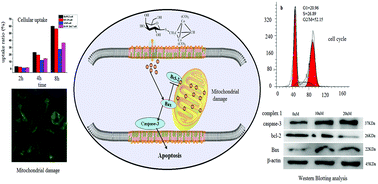当前位置:
X-MOL 学术
›
Org. Biomol. Chem.
›
论文详情
Our official English website, www.x-mol.net, welcomes your
feedback! (Note: you will need to create a separate account there.)
Syntheses and anti-cancer activity of CO-releasing molecules with targeting galactose receptors
Organic & Biomolecular Chemistry ( IF 2.9 ) Pub Date : 2018-10-09 , DOI: 10.1039/c8ob01921e Jili Li 1, 2, 3, 4 , Jinlong Zhang 1, 2, 3, 4 , Qiuping Zhang 1, 2, 3, 4 , Zhongjie Bai 1, 2, 3, 4 , Quanyi Zhao 1, 2, 3, 4 , Dian He 1, 2, 3, 4 , Zhen Wang 1, 2, 3, 4 , Yonglin Chen 3, 4, 5 , Bin Liu 3, 4, 6
Organic & Biomolecular Chemistry ( IF 2.9 ) Pub Date : 2018-10-09 , DOI: 10.1039/c8ob01921e Jili Li 1, 2, 3, 4 , Jinlong Zhang 1, 2, 3, 4 , Qiuping Zhang 1, 2, 3, 4 , Zhongjie Bai 1, 2, 3, 4 , Quanyi Zhao 1, 2, 3, 4 , Dian He 1, 2, 3, 4 , Zhen Wang 1, 2, 3, 4 , Yonglin Chen 3, 4, 5 , Bin Liu 3, 4, 6
Affiliation

|
CO-releasing molecules (CORMs) containing cobalt have many bioactivities, but most of them do not dissolve in water and have no selectivity to tissue and organs. On the basis of the specific recognition of galactose or sialic acid by a receptor, a series of CORMs based on carbohydrates were synthesized and evaluated. The test results show that all the complexes displayed anticancer activity. Among them, the effects of the complexes of galactose (1), GalNAc (8) and sialic acid (10) were very distinct. Complex 1 displayed higher activity against HeLa, HePG2, MCF-7 and HT-29 cell proliferation than cis-platin (DDP), and its selectivity was far much better than DDP compared with normal cell W138. Furthermore, the uptakes of complexes 1, 8 and 10 by HePG2, HT-29, A549 and RAW264.7 cell lines were studied. The uptake ratio of each cell line for complex 1 was different, and the order of uptake ratio in the four cell lines was HePG2 > HT-29 > RAW264.7 > A549. The HePG2 cells absorbed complex 1 beyond 60% after incubation for 8 h, while A549 absorbed only 27.8%. For complex 8, the uptake trend was similar to that of complex 1 with it being absorbed by all the four cancer cells, but the uptake rate was lower. However, differently, complex 10 was absorbed heavily by macrophage RAW264.7, followed by HePG2; after 8 h incubation, the uptake ratio of RAW264.7 was over 50%. In addition, the mechanism of action was explored, and the results showed that the complexes inhibited cell cycle arrest at the G2/M phase; complex 1 up-regulated the expression levels of caspase-3 and Bax, and down-regulated the Bcl-2 expression, giving rise to HePG2 cell apoptosis.
中文翻译:

靶向半乳糖受体的CO释放分子的合成及抗癌活性
含钴的释放CO的分子(CORM)具有许多生物活性,但大多数不溶于水,并且对组织和器官没有选择性。基于受体对半乳糖或唾液酸的特异性识别,合成和评估了一系列基于碳水化合物的CORM。测试结果表明,所有复合物均显示出抗癌活性。其中,半乳糖(1),GalNAc(8)和唾液酸(10)的复合物的作用非常明显。复合物1对HeLa,HePG2,MCF-7和HT-29细胞的增殖表现出比顺式更高的活性铂(DDP),其选择性远比正常细胞W138好于DDP。此外,复合物的摄取1,8和10通过的HePG2 HT-29,A549和RAW264.7细胞系进行了研究。复合物1的各细胞系的摄取率不同,这4种细胞系中的摄取率的顺序为HePG2> HT-29> RAW264.7> A549。孵育8小时后,HePG2细胞吸收复合物1超过60%,而A549仅吸收27.8%。对于复合物8,其吸收趋势类似于复合物1,其被所有四个癌细胞吸收,但是吸收率较低。但是,复杂的10被巨噬细胞RAW264.7和HePG2大量吸收。孵育8小时后,RAW264.7的吸收率超过50%。此外,探索了其作用机理,结果表明该复合物抑制了G2 / M期的细胞周期停滞。复合体1上调caspase-3和Bax的表达水平,下调Bcl-2的表达,引起HePG2细胞凋亡。
更新日期:2018-11-07
中文翻译:

靶向半乳糖受体的CO释放分子的合成及抗癌活性
含钴的释放CO的分子(CORM)具有许多生物活性,但大多数不溶于水,并且对组织和器官没有选择性。基于受体对半乳糖或唾液酸的特异性识别,合成和评估了一系列基于碳水化合物的CORM。测试结果表明,所有复合物均显示出抗癌活性。其中,半乳糖(1),GalNAc(8)和唾液酸(10)的复合物的作用非常明显。复合物1对HeLa,HePG2,MCF-7和HT-29细胞的增殖表现出比顺式更高的活性铂(DDP),其选择性远比正常细胞W138好于DDP。此外,复合物的摄取1,8和10通过的HePG2 HT-29,A549和RAW264.7细胞系进行了研究。复合物1的各细胞系的摄取率不同,这4种细胞系中的摄取率的顺序为HePG2> HT-29> RAW264.7> A549。孵育8小时后,HePG2细胞吸收复合物1超过60%,而A549仅吸收27.8%。对于复合物8,其吸收趋势类似于复合物1,其被所有四个癌细胞吸收,但是吸收率较低。但是,复杂的10被巨噬细胞RAW264.7和HePG2大量吸收。孵育8小时后,RAW264.7的吸收率超过50%。此外,探索了其作用机理,结果表明该复合物抑制了G2 / M期的细胞周期停滞。复合体1上调caspase-3和Bax的表达水平,下调Bcl-2的表达,引起HePG2细胞凋亡。











































 京公网安备 11010802027423号
京公网安备 11010802027423号